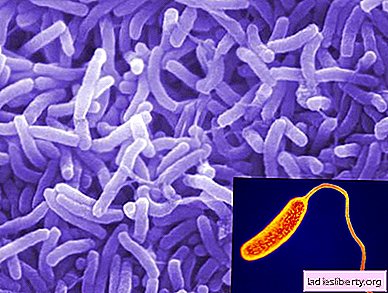
One of the most difficult diseases in terms of treatment and discomfort for the patient is demodicosis (subcutaneous tick).
Favorite places of defeat are the face and neck.
Contrary to the opinion that only unscrupulous people suffer from demodecosis, one can be assured of the opposite: infection does not depend on the careful observance of hygiene rules. Anyone can become infected, moreover, persons who abuse hygienic products risk even more.
Most often, young women suffer from demodicosis.
Although this disease does not pose a direct threat to health, it significantly reduces the quality of life: the patient is accompanied by constant itching, and in addition, the tick contributes to the formation of cosmetic defects, changing the patient's appearance.
To eliminate the cause in the early stages, and if possible, to prevent infection, you need to arm yourself with some knowledge.
Causes of development of a subcutaneous tick on the face
The main and immediate cause of infection is a decrease in local immunity. In a healthy person, the body's defense system instantly responds to external threats, suppressing infectious and parasitic lesions. In itself, a decrease in local immunity is provoked by several reasons.
The reason for this:
• Malfunctions of the endocrine system (during peak hormonal conditions or due to concomitant pathologies).
• Frequent use of aggressive cosmetics.
• Stress.
Demodecosis - the disease is extremely contagious. Transfer from carrier to carrier occurs by simple physical contact with the patient or items of clothing and hygiene. Often, infection occurs after using someone else's towel.
If infection has already occurred, the course of the subcutaneous tick on the face is aggravated by the following factors:
• abuse of coffee, alcohol, spicy spices.
• Stay in the bath, sauna, solarium.
• Exposure to ultraviolet skin.
As already mentioned, due to structural features of the skin, mainly women suffer.
Subcutaneous tick on the face: symptoms
Independently detecting demodicosis is not so simple. The disease successfully disguises itself as acne.
Symptoms of a subcutaneous tick on the face are still characteristic:
• First of all, there is a change in the intensity of sebum secretion. The skin becomes greasy, oily, acquiring shine, the pores expand. Various formations arise on it: ulcers, acne.
• The appearance of red spots is observed on the face.
• Due to persistent inflammation, the nose enlarges.
• The skin on the face changes its structure: it becomes bumpy.
• The leading symptom by which to determine the subcutaneous tick on the face is an unbearable painful itch. The parasite is most active in the dark, therefore, obvious manifestations are observed from evening to morning.
• If the tick settles in the eyelashes, they become thinner over time and begin to fall out. At the base of the eyelashes in the morning, the patient can detect scaly formations.
• In rare cases, the patient may feel movement under the skin.
• In especially severe cases, horny thickening of the affected skin occurs, significantly deforming the appearance of a person.
Together, these symptoms are characteristic not only for tick-borne lesions, but also for acne (acne). Only a doctor can clarify the situation.
Subcutaneous tick on the face: diagnosis
At the first sign of discomfort, it is recommended to consult a doctor immediately. Subcutaneous tick - a disease is not dangerous, but difficult to cure. It is much easier to fix the problem at the very beginning. A specialist who deals with skin pathologies is called a dermatologist. Often in medical institutions there is a combined specialty of a dermatologist-venereologist. Shy to visit such a doctor is not necessary, this is just a measure of economy and in no way a way to discredit the patient.
Diagnostic measures are standard and are not of great complexity.
A typical survey strategy includes:
• History taking. At the initial consultation, the doctor interviews the patient. The patient's task is to honestly and fully answer questions about the nature of complaints, the alleged circumstances of the infection, etc. The more fully a person will answer questions, the sooner the doctor will determine the further tactics of examination and treatment.
• Skin examination. Thanks to the examination, the specialist assesses the condition of the skin.
• Skin scraping is the main and most informative method for detecting demodicosis. The scales are sent to the clinical laboratory to determine the characteristic traces of the presence of the parasite.
As you can judge, the diagnosis is not a problem.
How to get rid of a subcutaneous tick on the face
Treatment of a subcutaneous tick on the face is not an easy task. Its solution requires an integrated approach and the efforts of doctors of several specialties at once. If eyelash damage is observed, you can not do without the help of an ophthalmologist, because there is a high probability of eye damage.
Therapy is traditionally medical. In addition to the local use of drugs, medication is being taken.
The groups of drugs are numerous:
• Antiparasitic drugs. By themselves, they have only a temporary healing effect. Unfortunately, the subcutaneous tick has high adaptive abilities, and the drugs of this group harm it for a very short time. However, drugs of the antiparasitic group are a good help in combination with other drugs.
• Antimicrobial agents. Contribute to a decrease in tick activity, including reproductive.
• Specialized cosmetics. Normalize the production of sebum.
• Antibiotics in the form of eye drops. They are used in ophthalmology for the treatment and prevention of eye damage.
• Antihistamines. When basophil cells (mast cells) are damaged, histamine substance extends beyond the cell membrane. This substance actively destroys other cells, causing intolerable itching. Antihistamines help reduce discomfort and relieve inflammation.
• Drugs that increase immunity.
• Preparations for strengthening vessels.
Specific names are selected by the attending specialist.
An important role is given to proper nutrition. Changes in the diet involve the rejection of sweet, fatty, smoked, spicy and salty foods. You should eat as many fresh vegetables and fruits as possible. A special diet has two goals: to optimize the functioning of the sebaceous glands and contribute to increased immunity.
Prevention of subcutaneous tick on the face
It’s much easier to prevent the disease than to treat it later. This battered wisdom is relevant at all times. Preventive measures, even if they do not allow one hundred percent guarantee security, but still significantly reduce the risk of infection.
• Proper nutrition. You should not abuse fatty foods, salty, sweet and spicy, if there is a tendency to increased secretion of sebum.
• Refusal of aggressive cosmetics and household chemicals.
• Good hygiene practices. It is important to find a middle ground here. Do not wash at all, but washing your face more than three times a day is not recommended. Thus, the person runs the risk of drying the skin, leaving it unprotected.
The subcutaneous tick is not as scary as you might think: there is no direct threat to health. Nevertheless, demodicosis is fraught with irreversible changes in appearance, as well as a mass of uncomfortable sensations. For this reason, it is recommended at the first suspicious signs to seek medical help, the sooner treatment is started, the easier it is to get rid of the parasite.











